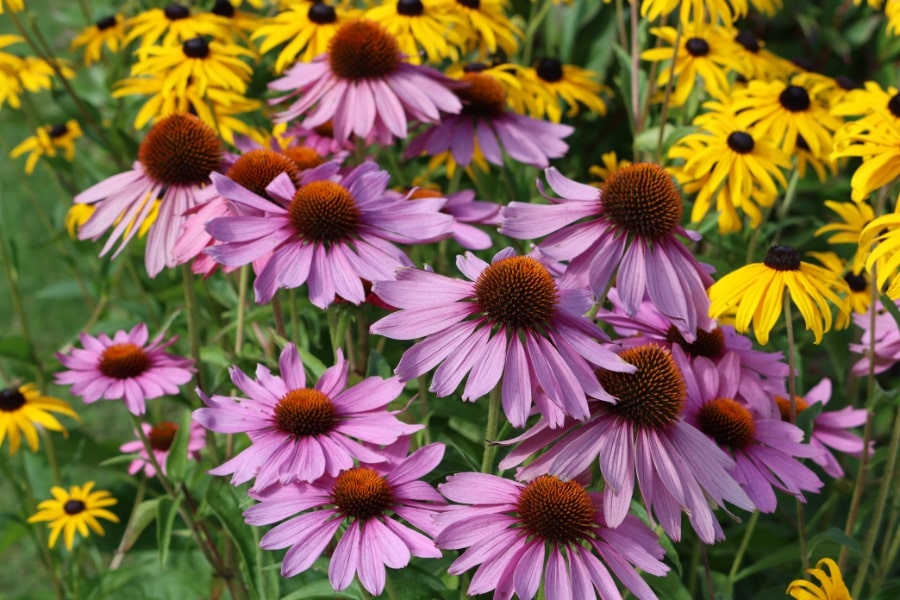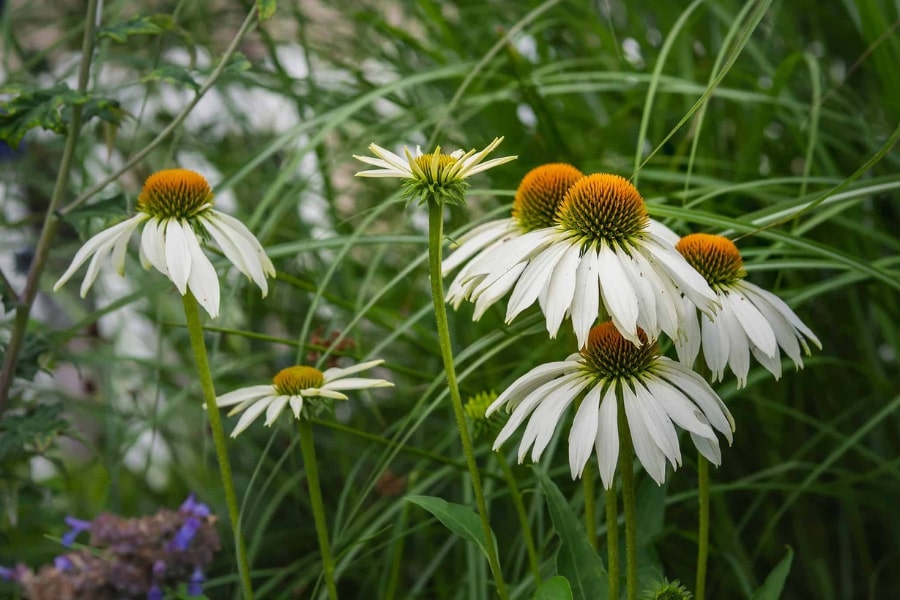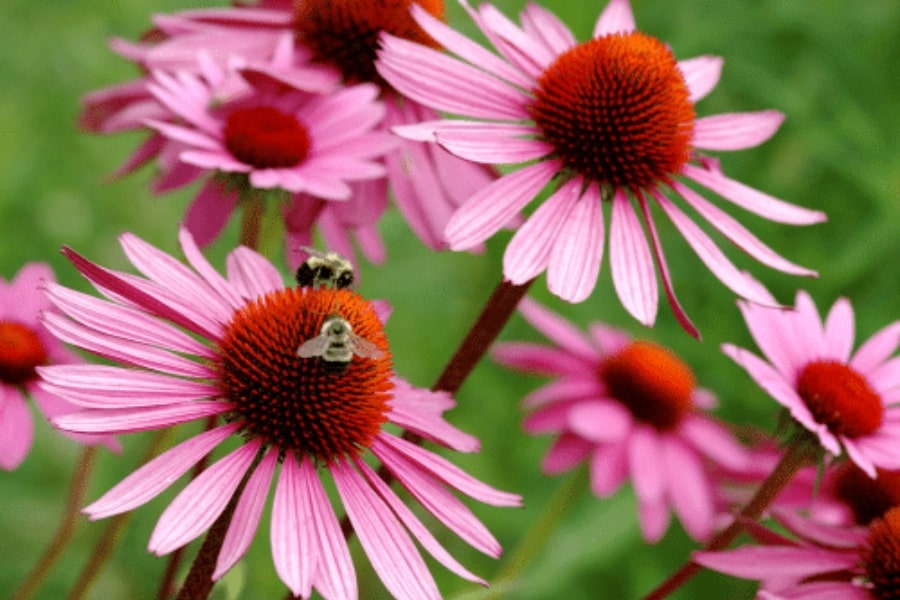Echinacea, also known as Coneflower, is a popular and hardy plant that belongs to the Asteraceae family. It is native to North America and is highly valued for its distinctive cone-shaped flowers that bloom throughout the hot summer months. When April showers and spring flowers are a footnote, that is when coneflowers begin. They are a hot season plant, and thrive in the hot sun after we have retreated indoors to our air conditioning.

Our Selection of Echinacea
At Martin Garden Center, we grow and sell numerous varieties but the tried and true most popular include the Magnus, POW WOW Series, and Cheyenne Spirit (yellow, orange and red blooms). However, we can’t help but bring in some of the amazingly colorful varieties to supplement these super performers. We are growing the following varieties in 2025:
- Artisan™ Red Ombre
- Artisan™ Yellow Ombre
- Cheyenne Spirit
- Magnus
- POW WOW™ White
- POW WOW™ Wild Berry
- Sombrero® Adobe Orange
- SunSeekers Rainbow
- SunSeekers Salmon
- SunSeekers Sweet Fuchsia
Generally, Coneflowers bloom from Summer to Fall. We begin seeing 4″ Coneflowers on the perennial tables at Martin Garden Center in mid-Summer. We also may have 1-gal available from time to time. So plan on waiting until late June for Coneflowers to be ready. However, once Echinacea is ready for sale, we attempt to keep all colors in stock all Summer until first frost. We aren’t always able to keep these plants stocked throughout the summer, but we do try. Just don’t expect Coneflowers to be available in the Spring because it just isn’t going to happen, my friend!
Growing and Caring For Coneflowers
Echinacea thrives in various growing conditions, making it a versatile addition to gardens of various styles and locations. Coneflower is well-suited to temperate climates and can withstand cold winters. It is a hardy perennial that can thrive in a range of USDA hardiness zones, making it a reliable choice for gardens in various regions. It is a sun-loving plant that flourishes when exposed to ample sunlight, ideally six to eight hours of direct sunlight each day, and the heat of the summer.
Well-draining soil is essential for Echinacea’s health and growth; it prefers soil rich in organic matter and allows excess water to drain away, preventing root rot. The plant’s adaptable nature means it can tolerate a range of soil types, from loamy to sandy. Echinacea is relatively drought-tolerant once established. During its early stages of growth, consistent watering is necessary to help the plant develop a strong root system. However, once it is established, it can withstand periods of dryness without compromising its overall health. Overwatering is the kiss of death for coneflowers.
Caring for Echinacea involves deadheading spent flowers, as this is essential to promote continuous blooming and prevent the plant from redirecting energy into seed production. Removing faded blooms also maintains the plant’s aesthetic appeal and prevents self-seeding. Echinacea generally does not require heavy fertilization. A balanced, slow-release spring fertilizer can provide the nutrients for healthy growth and flowering.
Coneflowers tends to be susceptible to powdery mildew so watch closely when the autumn nights are cool for signs of mildew. Copper fungicide is an organic pesticide that helps prevent powdery mildew.

Leaves and Flowers
Echinacea’s leaves and flowers form a harmonious duet of beauty, each contributing to the plant’s visual splendor. Its lance-shaped, coarse-textured leaves are typically dark green and radiate from a central stem. Some Echinacea varieties exhibit unique leaf colors, such as green, purple, and even silver variations, adding an intriguing touch of diversity to the garden landscape.
Echinacea’s most iconic feature is undoubtedly its flowers; the blossoms boast a prominent central cone, often referred to as a “cone” or “disk,” surrounded by a vibrant ring of petals. The petals, also known as ray florets, come in many captivating colors, including shades of pink, purple, white, and orange. The contrast between the central cone and the radiating petals creates a visually captivating spectacle that beckons pollinators and garden enthusiasts alike. The flowers also serve as important nectar sources for pollinators, including bees, butterflies, and hummingbirds.

Uses in the Garden
1. Pollinator-Friendly Gardens: Echinacea’s nectar-rich flowers attract diverse pollinators, making it a valuable addition to pollinator-friendly gardens that support local wildlife and contribute to ecological balance.
2. Cottage Gardens: Echinacea’s rustic charm and vibrant colors make it a perfect fit for cottage-style gardens, adding a touch of nostalgia and romance to outdoor spaces.
3. Native Plant Landscapes: As a native North American plant, Echinacea seamlessly integrates into native plant landscapes, enhancing these garden settings’ authenticity and ecological value.
4. Cut Flower Arrangements: Echinacea’s stunning blossoms are prized for their beauty and longevity in cut flower arrangements. Their striking appearance adds a touch of elegance to indoor spaces.

Frequently Asked Questions
Do Deer And Rabbits Eat Echinacea?
Deer and Rabbits generally avoid eating coneflowers (Echinacea). Coneflowers are considered deer-resistant because they contain compounds that make them less appealing to deer. Rabbits typically avoid eating echinacea due to its slightly bitter taste and tough, fibrous foliage. However, in times of scarcity or when other food sources are limited, deer and rabbits may occasionally nibble on echinacea plants, particularly young shoots or tender new growth.
Are Coneflowers Perennial?
Yes, coneflowers (Echinacea) are perennials. Perennials are plants that live for more than two years, and coneflowers fit this category. Coneflowers are hardy and typically return year after year when planted in suitable growing conditions.
Are Rudbeckia And Echinacea The Same?
Rudbeckia and Echinacea are not the same, although they do belong to the same family, Asteraceae. They share some similarities, such as their tolerance to drought and preference for sunny conditions, though they have different appearances, growth habits, and uses in gardens.
Rudbeckia, also known as black-eyed Susan, is a vibrant plant with bright yellow or orange petals surrounding a dark center. This plant, valued for its long bloom time and ability to withstand drought, is a popular choice for gardens and landscapes. Echinacea, on the other hand, boasts prominent, daisy-like blooms with distinctive raised centers. Echinacea is renowned for its medicinal properties and is often used in herbal remedies to boost the immune system.
When Do Coneflowers Bloom?
Coneflowers (Echinacea) generally bloom from mid spring through late summer, with the peak bloom period typically occurring in early to midsummer. In the Upstate, we enjoy Coneflower blooms as early as April. The specific timing of coneflower blooms can vary depending on factors such as the local climate, the particular species or variety of coneflower, and growing conditions.
Are Coneflowers Toxic To Dogs?
Echinacea, commonly known as coneflower, is considered non-toxic to dogs. In fact, Echinacea is sometimes used in herbal supplements for pets to support their immune system and overall health. However, while Echinacea is not known to be harmful to dogs when consumed in small amounts, it’s always best to monitor your pet’s behavior after exposure to any new plant or substance.
Echinacea
